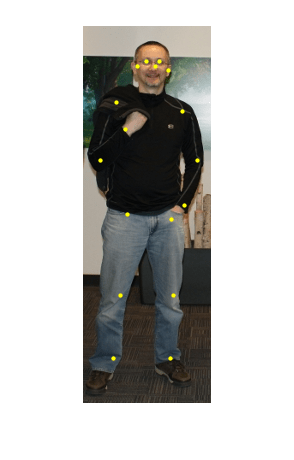detect
Syntax
Description
keypoints = detect(detector,I,bboxes)I, using an HRNet
object keypoint detector, detector. The detect
function automatically resizes and rescales the input to match the size of the images used
to train the detector. The function returns the locations of keypoints detected in each
input image as a set of object keypoints.
[
returns the detection confidence score for each keypoint. The confidence score determines
the location accuracy of the detected keypoint. The value of keypoint confidence score is
in the range of [0, 1]. A higher score indicates greater confidence in the
detection.keypoints,scores] = detect(detector,I,bboxes)
detectionResults = detect(___,Name=Value)KeypointSize=2 specifies the keypoint size to be two pixels.
Examples
This example uses:
Read a sample image into the workspace.
I = imread("visionteam.jpg");Crop and display one person from the image.
personBox = [262.5 19.51 127.98 376.98]; [personImg] = imcrop(I,personBox); figure imshow(personImg)

Specify a bounding box for the person in the image. You can use the bounding box region as input to the object keypoint detector to detect the person.
bbox = [3.87,21.845,118.97,345.91];
Load a pretrained HRNet object keypoint detector.
keypointDetector = hrnetObjectKeypointDetector("human-full-body-w32");Detect the keypoints of the person in the image by using the pretrained HRNet object keypoint detector.
[keypoints,keypointScores,valid] = detect(keypointDetector,personImg,bbox)
keypoints = 17×2 single matrix
72.8781 40.7078
77.1927 36.2037
63.9647 36.2037
86.2008 45.2118
55.2407 40.7078
100.2811 85.7481
33.9517 76.7401
114.5508 135.2925
17.5455 135.2925
102.2699 180.3329
43.3386 103.7643
89.3260 193.8450
45.1380 189.3410
90.9360 270.4136
38.0240 270.4136
⋮
keypointScores = 17×1 single column vector
0.9616
0.9819
0.9797
0.9824
0.9627
0.9540
0.8812
0.9696
0.9909
0.9675
0.9327
0.8247
0.8356
0.9527
0.9111
⋮
valid = 17×1 logical array
1
1
1
1
1
1
1
1
1
1
1
1
1
1
1
⋮
Insert the person keypoints into the image and display the results.
detectedKeypoints = insertObjectKeypoints(personImg,keypoints,KeypointColor="yellow",KeypointSize=2);
imshow(detectedKeypoints)
Input Arguments
HRNet object keypoint detector, specified as an hrnetObjectKeypointDetector object.
Test images, specified as a numeric array of size H-by-W-by-C-by-T. Images must be real, nonsparse, and RGB.
H— Height of the image, in pixels.
W— Width of the image, in pixels.
C— The channel size in each image must be equal to the input channel size. Because this function requires RGB images, the channel size must be
3.T— Number of test images in the array. The function computes the object keypoint detection results for each test image in the array.
The intensity range of the test image must be similar to the intensity range of the
images used to train the detector. For example, if you train the detector on
uint8 images, rescale the test image to the range [0, 255] by using
the im2uint8 or rescale
function. The size of the test image must be comparable to the sizes of the images used
in training. If these sizes are very different, the detector has difficulty detecting
object keypoints because the scale of the objects in the test image differs from the
scale of the objects the detector is trained to identify.
Data Types: uint8 | uint16 | int16 | double | single
Locations of the objects detected in the input image or images, specified as one of these options:
M-by-4 matrix— The input is a single test image. M is the number of object bounding boxes in the image.
T-by-1 cell array— The input is an array of test images. T is the number of test images in the array. Each cell contains an M-by-4 matrix of object bounding boxes for the corresponding image, where M is the number of bounding boxes in the image.
The table describes the possible formats of bounding boxes.
| Bounding Box | Description |
|---|---|
rectangle |
Defined in spatial coordinates as an M-by-4 numeric matrix with rows of the form [x y w h], where:
|
Data Types: uint8 | uint16 | int16 | double | single
Test images, specified as an ImageDatastore, CombinedDatastore, or
TransformedDatastore
object containing the full filenames of the test images. The images in the datastore
must be RGB images.
When using the read function the datastore ds must return a table
or a cell array with these columns:
image data | bboxes | box labels |
|---|---|---|
| T-by-1 cell array, in which each cell contains an input image. The images in the datastore must be RGB images. | T-by-1 cell array, in which each cell contains an M-by-4 matrix of 2-D bounding boxes specifying object locations within the corresponding input image. Each row of the matrix specifies the location of a bounding box in the format [x y w h]. | T-by-1 cell array, in which each cell contains an M-by-1 categorical vector of object class names. All the categorical data returned by the datastore must use the same categories. |
Name-Value Arguments
Specify optional pairs of arguments as
Name1=Value1,...,NameN=ValueN, where Name is
the argument name and Value is the corresponding value.
Name-value arguments must appear after other arguments, but the order of the
pairs does not matter.
Example: detect(detector,I,MiniBatchSize=16) detects object keypoints
in each image using 16-element batches of bounding boxes.
Minimum batch size, specified as a positive integer. Use the
MiniBatchSize argument when processing an image with a large
number of objects. When you specify this argument, the function groups the bounding
boxes surrounding the objects into batches of the specified size and processes them
together to improve computational efficiency. Increase the minimum batch size to
decrease processing time. Decrease the size to use less memory.
Hardware resource on which to run the detector, specified as
"auto", "gpu", or "cpu".
"auto"— Use a GPU if it is available. Otherwise, use the CPU."gpu"— Use the GPU. To use a GPU, you must have Parallel Computing Toolbox™ and a CUDA®-enabled NVIDIA® GPU. If a suitable GPU is not available, the function returns an error. For information about the supported compute capabilities, see GPU Computing Requirements (Parallel Computing Toolbox)."cpu"— Use the CPU.
Performance optimization, specified as one of these options:
"auto"— Automatically apply a number of optimizations suitable for the input network and hardware resource."mex"— Compile and execute a MEX function. This option is available only when using a GPU. Using a GPU requires Parallel Computing Toolbox and a CUDA enabled NVIDIA GPU. If Parallel Computing Toolbox or a suitable GPU is not available, then the function returns an error. For information about the supported compute capabilities, see GPU Computing Requirements (Parallel Computing Toolbox)."none"— Disable all acceleration.
The default option is "auto". If you specify
"auto", MATLAB® applies a number of compatible optimizations. The
"auto" option, MATLAB never generates a MEX function.
Using the Acceleration options "auto" and
"mex" can offer performance benefits, but at the expense of an
increased initial run time. Subsequent calls with compatible parameters are faster.
Use performance optimization when you plan to call the function multiple times using
new input data.
The "mex" option generates and executes a MEX function based on
the network and parameters used in the function call. You can have several MEX
functions associated with a single network at one time. Clearing the network variable
also clears any MEX functions associated with that network.
The "mex" option is available only for input data specified as
a numeric array, cell array of numeric arrays, table, or image datastore. No other
type of datastore supports the "mex" option.
The "mex" option is available only when you use a GPU. You
must also have a C/C++ compiler installed. For setup instructions, see Set Up Compiler (GPU Coder).
"mex" acceleration does not support all layers. For a list of
supported layers, see Supported Layers (GPU Coder).
Output Arguments
Locations of object keypoints detected in the input image or images, returned as one of these options:
17-by-2-by-M array — The input is a single test image. Each row in the array is of the form [x y] where x and y specify the location of a detected keypoint in an object. M is the number of objects in the image.
T-by-1 cell array — The input is an array of test images. T is the number of test images in the array. Each cell in the cell array contains a 17-by-2-by-M array specifying the keypoint detections for the M objects in the image.
Each object has 17 detected keypoints.
Data Types: double
Detection confidence scores for object keypoints, returned as one of these options:
17-by-M matrix — The input is a single test image. M is the number of objects in the image.
T-by-1 cell array — The input is an array of test images. T is the number of test images in the array. Each cell in the array contains a 17-by-M matrix indicating the detection scores for the keypoints of each of the M objects in an image.
Each object in an image has 17 has keypoint confidence scores. A higher score indicates higher confidence in the detection.
Data Types: double
Validity of the detected object keypoints, returned as one of these options:
17-by-M logical matrix — The input is a single test image. M is the number of objects in the image.
T-by-1 cell array — The input is an array of test images. T is the number of test images in the array. Each cell in the array contains a 17-by-M logical matrix indicating the keypoint validity values for the keypoints of each of the M objects in the corresponding image.
Each object in an image has 17 keypoint validity values. A value of
1 (true) indicates a valid keypoint and
0 (false) indicates an invalid keypoint.
Data Types: logical
Detection results, returned as a two-column table with variable names
Keypoints and Scores. Each element of the
Keypoints column contains a 17-by-2-by-M array,
for M objects in the image. Each row of the array contains a keypoint
location for the corresponding object in the format [x
y]. Each element of the Scores column contains
17-by-1-by-M array, where M is the number of
objects in the image. Each row of the array contains the keypoint detection confidence
score for one of the 17 keypoints in the corresponding object in that image.
Extended Capabilities
The
detectfunction does not supportImageDatastoreobject as input for code generation.Code generation does not support the
MiniBatchSize,ExecutionEnvironment, andAccelerationname-value arguments fordetect.To prepare an
hrnetObjectKeypointDetectorobject for code generation, useloadHRNETObjectKeypointDetector.
The
detectfunction does not supportImageDatastoreobject as input for code generation.Code generation does not support the
MiniBatchSize,ExecutionEnvironment, andAccelerationname-value arguments fordetect.To prepare an
hrnetObjectKeypointDetectorobject for code generation, useloadHRNETObjectKeypointDetector.
GPU Arrays
Accelerate code by running on a graphics processing unit (GPU) using Parallel Computing Toolbox™.
Version History
Introduced in R2023bStarting from R2025a, you can vary the number of bounding boxes specified as input to
the detect function during code generation. This means that the
limitations on bounding boxes from previous releases have been removed. You can now assign
bounding boxes dynamically during runtime.
Prior to R2024b, the bboxes argument to the detect
function must be a code generation constant (coder.const()) and a
M-by-4 matrix. The number of bounding boxes M and
the values of the bounding boxes must be fixed for code generation.
Starting from R2024b, you can dynamically adjust the bounding box values during runtime.
However, the number of bounding boxes M must be a code generation
constant.
MATLAB Command
You clicked a link that corresponds to this MATLAB command:
Run the command by entering it in the MATLAB Command Window. Web browsers do not support MATLAB commands.
Web サイトの選択
Web サイトを選択すると、翻訳されたコンテンツにアクセスし、地域のイベントやサービスを確認できます。現在の位置情報に基づき、次のサイトの選択を推奨します:
また、以下のリストから Web サイトを選択することもできます。
最適なサイトパフォーマンスの取得方法
中国のサイト (中国語または英語) を選択することで、最適なサイトパフォーマンスが得られます。その他の国の MathWorks のサイトは、お客様の地域からのアクセスが最適化されていません。
南北アメリカ
- América Latina (Español)
- Canada (English)
- United States (English)
ヨーロッパ
- Belgium (English)
- Denmark (English)
- Deutschland (Deutsch)
- España (Español)
- Finland (English)
- France (Français)
- Ireland (English)
- Italia (Italiano)
- Luxembourg (English)
- Netherlands (English)
- Norway (English)
- Österreich (Deutsch)
- Portugal (English)
- Sweden (English)
- Switzerland
- United Kingdom (English)